These last few weeks have been full of vintage distractions. Besides setting up the Costume Exhibit, we added a vintage camper trailer to our vintage collection. While this isn’t a fashion related post, it is one more thing to do in vintage clothing. Vintage Clothing and Vintage Cars/trailers go hand in hand 🙂 Here is a rundown of why we chose a vintage camper and what we learned along the way to help you get started too.
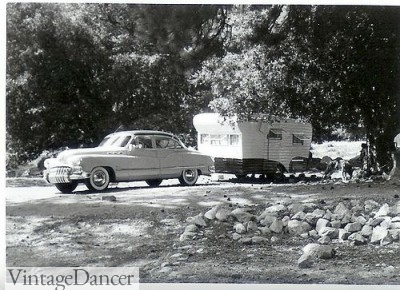
Vintage Photo of a Trailer
While a vintage “canned ham” camper has been on our list of things to buy someday, it was quickly elevated to “must buy now” when we decided to go camping with friends a few weeks ago. We looked into renting an RV and nearly fell over at the price of a weekend rental. So instead, I jumped on Craigslist to see what we could buy. The stars must have been in alignment for us because about an hour away was a happy little 13 foot 1967 Cadillac De Ville in our budget. Over the next few weeks, we scrambled to get the outside ready for safe traveling (fixing wiring issues), redecorating the inside (the fun part of camping/glamping) and making our car tow ready. As we pulled out of our house and onto the open road, we held our breath and crossed out fingers that we would make it to the campsite in one piece. Thankfully, we did. We had so much fun we plan to camp a few more times this summer.
The Vintage Camper Craze
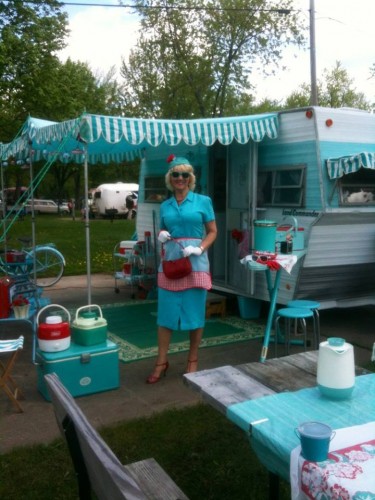
A few years ago, I had no idea there was such a craze for vintage campers. Cars, yes, but campers? An old boyfriend and I were almost given a 1948 Aljo camper. I looked online to see what they originally looked like and I was shocked to see a huge community of vintage camper enthusiasts that were restoring and rebuilding these old trailers. When finished, they would take them to “Vintage Trailer Rallies” gatherings of pre-1970s trailers, similar to show ‘n shines for vintage cars. At these rallies, people have fun with vintage or themed decor both inside and outside of their trailers. Wearing vintage style clothing is a plus, too. Often, a second support vehicle is needed to haul all the “stuff.” If you want to see what I mean just Google or Pinterest search for “Vintage Trailer” or “Vintage Camper.”
The Rallies sound like a blast. We hope to make it to the nearest one to us next Spring. Since our color scheme is more of a ’50s palette than ’60s, I have been collecting retro teal and red kitchen gear (Costplus World Market has both right now) and vintage camping chairs. However, since our main objective was not to “glamp” but to actually camp in the trailer, we are keeping all the unnecessary retro decor to a minimum. Luckily, most vintage trailer owners do both glamping and camping, so the endless advice from this community of enthusiasts is very helpful.
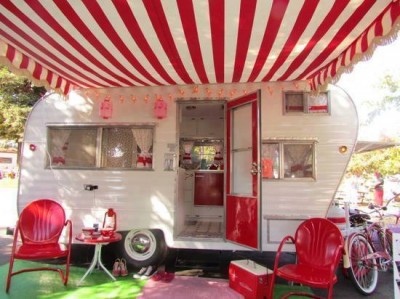
Love this Retro Camper Color Scheme (source VCT Facebook)
If you want to get social with the vintage trailer community I suggest you join Tin Can Tourist and Vintage Camper Trailers Facebook groups. Follow their Pinterest Boards too: Tin Can Tourist and Vintage Camper Trailers. Both groups have optional memberships which help you find local Rallies to attend and mingle with other local groups. VCT also produces a magazine that is worth subscribing too.
How to Find a Vintage Camper
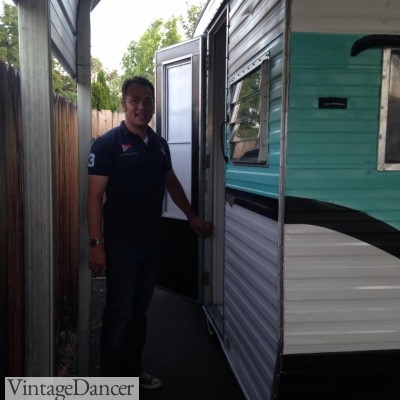
Bring our “new” camper home
The easiest way to locate a Vintage Camper Trailer is through your local Craigslist listings. Search for “vintage” or “retro” and you will get a better selection. How retro you want to go is up to you. Most collectors/Rally groups prefer trailers that are pre-1970. Shasta, Scotty, Airstream, and Tear Drops are the most popular brands, but by no means the “best.” Our De Ville was a pricey luxury trailer made just in California for about 30 years. They are more rare, but very well made, so they are often in better condition than other brands. Many people are starting to get post-1970s trailers because they are usually cheaper and they can decorate them in a colorful retro color scheme.
On Craigslist, be sure to look in nearby areas too. Ours was not listed locally, but instead in San Francisco’s Craigslist. We would have never found it if it wasn’t for the expanded search. Pricing will range based on condition and your location. We paid $3500 for ours, which I thought was a bargain considering it was in mostly good working condition. In other parts of the country, that would be sky high. Most trailers start at $500 and can go up to $30K for a completely rebuilt trailer.
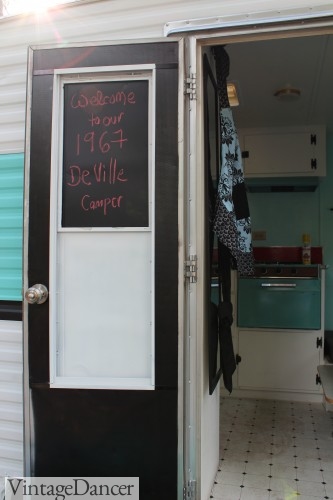
The next best option for finding a good bargain on a trailer is that will probably need a bit more work is to go door to door. On our way to camping this past weekend, we drove through a lot of small farm towns. Nearly every farm had a vintage trailer sitting on their property not getting used. Plenty of buyers simply knock on the door and ask if its for sale. Usually the owners are happy to have someone take it off their hands. Driving through suburban neighborhoods may also find you a camper for sale. I see many campers sitting in side yards in my neighborhood. These campers are more likely to be in better shape and will cost you a bit more.
Online listing classifieds are another option, especially if you want a fully rebuilt/restored camper. Tin Can Tourist, VCT, and others all have listings of campers for sale.
Avoid buying sight unseen on eBay. The horror stories of campers that are sold on eBay is enough to keep me even from looking. However, if you see one close enough to you to take a look in person at it, then by all means go check it out.
It may be that a true vintage trailer is not a good option for you. One of the many new retro-style trailers and RVs may be better with modern conveniences, a newer engine, bigger size/more beds, and yet still have plenty of vintage-retro designs features. After reading this article, my family is seriously considering upgrading to the new 1960s inspired Winnebago Brave.
How to buy a vintage camper
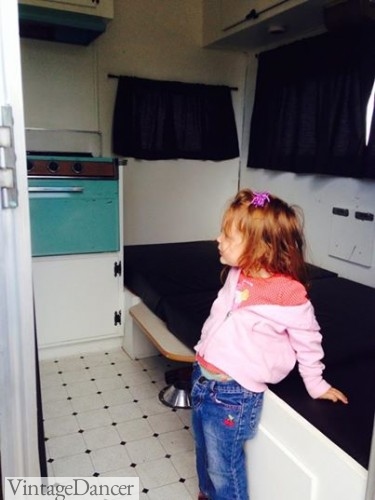
My daughter checking out the trailer. She claimed her bed first.
My hubby and I an not restorers. We don’t mind fixing some things and decorating is right up my talent pool, but we were not looking for a heavy fixer upper. We read some good guides on how to evaluate a vintage camper before buying, which helped. Ultimately, we just went with our gut and said yes to our trailer without going through each and every step. In hindsight, we should have checked a few things out a bit more.
For example, one tail light didn’t work. That was something important we should have insisted the previous owners fix – since technically it’s illegal to tow with a broken light. We fixed it after several tries so its was road ready by the time we camped. Other things in hindsight – the paint was cheap exterior spray paint. It needs to be car paint at a minimum. We will have to redo the paint job in a year or so. Everything was painted white on the inside. Paint hides a multitude of sins. Our only choice is to strip it all down (and see rotting wood and scratched counters) or paint it to our liking. We chose to paint it, including the counter tops. Maybe someday we’ll hire someone to do a full strip and rebuild of the damaged wood and laminate. For now, paint fixes everything : )
Towing the Camper Trailer
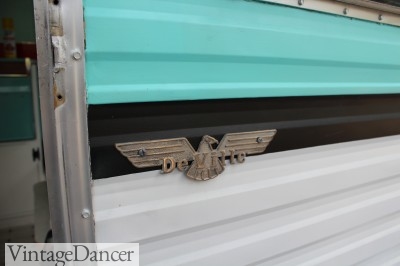
The De Ville logo. Love it.
We have never towed anything in our lives. Our car, a Hyundai Santa Fe with V6 engine, was strong enough to pull 3500lbs. Our trailer weighs around 1600-2000, so we were within limits, but we certainly could feel the engine working hard to get uphill. We are now considering buying a truck or SUV with a larger engine to make hauling a little easier. Most people like small campers because they can be towed with smaller cars. If you don’t have many mountain roads to travel on, you’ll probably be fine. Do your research both on your car and the towing weight of the camper when full (add a few hundred pounds from the dry trailer weight, more if you have a large water tank, AC, fridge, or bathroom).
Learn to tow, including how to hook it all up, unhook, back up (the hardest) and make wide turns. Getting some lessons from a towing savvy friend is the best help, otherwise there are plenty of resources online. Find an empty parking lot and practice towing and backing up. Knowing how to replace wire that can break en-route is also handy. Having a spare trailer tire is also recommended. Basically, whatever you need for your car, you will also need for your trailer.
Other things you will want to learn. How to use your sink/water reservoir, propane tank/stove, AC, fridge, and bathroom. We didn’t use any of this on our first camping trip. For the next one, we will get the stove working. (We ran out of firehood and there was a power outage at the nearest store, so we were out of luck for breakfast our last day. Having a working stove would have been handy, although I prefer to campsite cook whenever possible).
What to pack in your Vintage Trailer
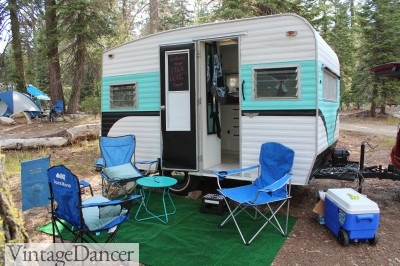
Our 67 DeVille Camper all set up for our first camping trip
Bed- Sleeping on a pull-out bed in the trailer is so much more comfortable than a tent mattress. We used just our sleeping bags, but next time we’ll do what most glampers do and put down a memory foam type mattress complete with sheets and a comforter (Costco and Ikea both sell good, cheaper, options). It will be that much more comfortable.
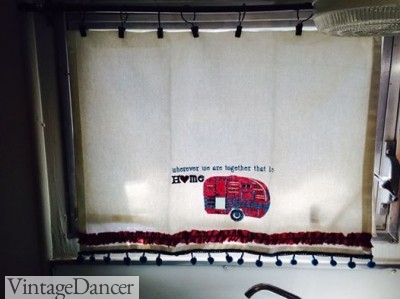
Found these cute camper kitchen towel turned curtains at Word Market
Kitchen- Do yourself a favor and go to the dollar store for a complete kitchen- plates, cups, wash basins, silverware, oven mitts, tongs, knives, ladle, matches, strainer, can opener, tinfoil, storage containers, hand towels, paper towels, salt and pepper shakers, laundry bag, toys for the kids, glow sticks, water, and food. The nice thing about having a trailer is that all of it stays in the trailer. No more hours of packing up and unpacking your own kitchen.
Storage unit- Most trailers come with a storage cabinet. Ours is lacking shelves at the moment, but it will be handy next time for holding a broom and dustpan (trailers get dirty), dirty laundry, extra supplies, and a collection of tools to fix anything and everything in your trailers. Tape, nails, screws, screw driver, bungee cords, wiring kit, levelers, and a rock to put under your tire.
Bathroom – Our small trailer does not have a bathroom. Normally that is no big deal for us, because we always camp with at least an outhouse on the campsite. However, since I am 5 months pregnant and prone to frequent potty breaks at night, we bought a Luggable Loo. They came highly rated by other vintage campers. Essentially it is a 5 gallon bucket with a snap-on toilet lid. You can buy the “poop bags” made for it or just double bag regular kitchen trash bags and place either a diaper or two at the bottom or clumping cat litter. Toss the bag in the trash after each use. This method is both cheap and mostly stink free. Don’t forget the toilet paper!
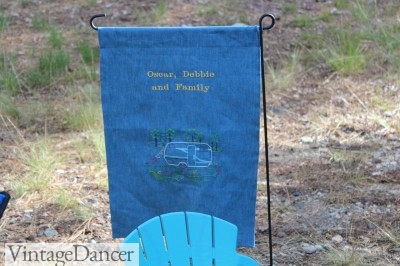
My friend made this cute banner for us. It makes the vintage camping experience that much more enjoyable.
Outside – This is where you can go with traditional camping supplies or vintage retro goodies. At a minimum, we recommend camping chairs (vintage or new), a garbage can, a small side table, a larger card table size for cooking prep, large cooler with ice and perishable food, several water jugs, table cloth and an outdoor rug or AstroTurf carpet (bought at Home Depot).
More glamping accessories – White picket fence to go around the trailer hitch, pink flamingos, trailer awning, string lights (or glow sticks), vintage luggage (can double as dry food storage), signage (people love to know the year of your trailer), fan (battery powered, 12V, or electric depending on your outlets), a screen door or net to keep bugs out, step stool (two level steps is ideal), and vintage bikes. Inside you can add cute curtains, throw pillows, bedding, kitchen accessories, funny signs, vintage food and beverages (we like the vintage sodas from Cost Plus Word Market).
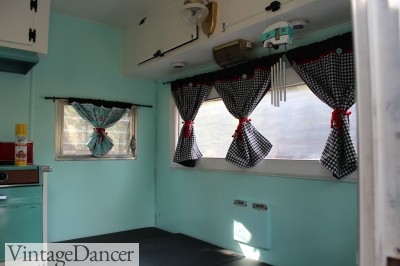
I made these curtains to spruce up the inside of the trailer.
Well that’s it for this little lesson in getting started camping with a Vintage Camping Trailer. Do you have one? Leave a comment with a link to your pictures or join this Facebook group just for DeVille trailer owners. I would love to oooh and ahhh over yours!
Debbie Sessions has been teaching fashion history and helping people dress for vintage themed events since 2009. She has turned a hobby into VintageDancer.com with hundreds of well researched articles and hand picked links to vintage inspired clothing online. She aims to make dressing accurately (or not) an affordable option for all. Oh, and she dances too.